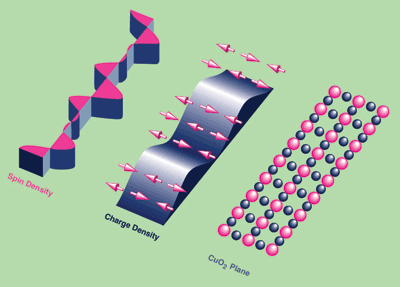‘Striped’ material offers clues to high-temperature superconductivity
Scientists studying a material that appeared to lose its superconductivity say new measurements reveal that the material is indeed a superconductor — but only in two dimensions. This 2D superconductivity emerges at a higher temperature than ordinary 3-D superconductivity. The research was conducted in part by physicist John Tranquada at the DOE’s Brookhaven National Laboratory (www.bnl.gov).

Stripe order in the copper oxide planes involves both a modulation of the charge density and a modulation of the arrangement of magnetic dipole moments (spin directions) on copper atoms.
The basic idea behind superconductivity is that electrons, which ordinarily repel one another, pair up to carry electrical current with no resistance. Conventional metallic superconductors do this at near 0 K, requiring costly cooling systems. Recently, materials have been discovered that transition to superconductivity at higher temperatures.
Tranquada and his colleagues have been studying a layered material made of lanthanum, barium, copper, and oxygen (LBCO) where the ratio of barium to copper atoms is exactly 1 to 8. At this ratio the transition temperature to superconductivity drops way down to near 0 K, while at higher and lower ratios LBCO acts as a “high-temperature” superconductor.
The material exhibits an unusual pattern of charge and magnetism known as “stripes,” which many theorists have long assumed was incompatible with superconductivity. A key measurement, made by physicist Qiang Li, was of electrical resistance parallel and perpendicular to the planes of the layered material. At a particular temperature, a big drop in resistance was detected when the current was flowing parallel to the layers, but not when it was flowing perpendicular to them. At the same time, physicists Markus Hücker and Li noted the onset of weak “diamagnetism,” an effect in which magnetic fields are pushed out of the sample and one of the key properties of a superconductor (the Meissner effect). For more, see http://www.bnl.gov/bnlweb/pubaf/pr/PR_display.asp?prID=865.
Jim Harrison
Advertisement
Learn more about Electronic Products Magazine





